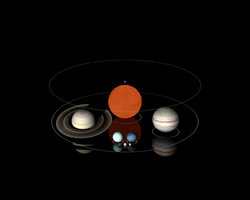| Observation data Epoch J2000.0 Equinox J2000.0 (ICRS) | |
|---|---|
| Constellation | Carina [1] |
| Right ascension | 11h 06m 51.99s [2] |
| Declination | −60° 51′ 45.7″ [2] |
| Characteristics | |
| Spectral type | ? (primary)/M (b) [3] |
| Apparent magnitude (I) | 15.61 (system) [2] |
| Variable type | Eclipsing binary |
| Orbit [3] | |
| Period (P) | 7.26867 d |
| Eccentricity (e) | 0.205 ± 0.008 |
| Inclination (i) | 88–90° |
| Periastron epoch (T) | JD 2452342.41 ± 0.02 |
| Argument of periastron (ω) (secondary) | 99.2 ± 0.8° |
| Semi-amplitude (K1) (primary) | 9.642 ± 0.088 km/s |
| Details [3] | |
| OGLE-TR-122A | |
| Mass | 0.98 ± 0.14 M☉ |
| Radius | 1.05+0.20 −0.09 R☉ |
| Surface gravity (log g) | 3.9 ± 0.5 cgs |
| Temperature | 5700 ± 300 K |
| Metallicity [Fe/H] | 0.15 ± 0.36 dex |
| Rotational velocity (v sin i) | 5.7 ± 0.6 km/s |
| OGLE-TR-122B | |
| Mass | 0.092 ± 0.009 M☉ |
| Radius | 0.120+0.024 −0.013 R☉ |
| Other designations | |
| V817 Car | |
| Database references | |
| SIMBAD | data |
OGLE-TR-122 is a binary stellar system containing one of the smallest main-sequence stars whose radius has been measured. It was discovered when the Optical Gravitational Lensing Experiment (OGLE) survey observed the smaller star eclipsing the larger primary. The orbital period is approximately 7.3 days. The system's primary is thought to resemble the Sun. [3]

